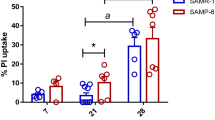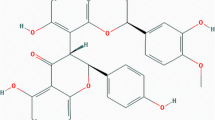Abstract
Since the worldwide approval of lithium therapy in 1970, lithium has been used for its anti-manic, antidepressant, and anti-suicidal effects. The last decade has witnessed the following discoveries about its neuroprotective and neurotrophic properties, yet the therapeutic mechanisms at the cellular level remain not-fully defined. We have undertaken the present study to determine if chronic lithium treatment, at therapeutically relevant concentrations, exerts neurotrophic/neuroprotective effects in the mouse brain in vivo. For this purpose, 10 months aged mice were fed for 3 months on food pellets contained 1 g (L1 group) or 2 g (L2 group) lithium carbonate/kg, resulting in serum concentrations of 0.4 and 0.8 mM, respectively. The evaluation of lipid peroxidation level and the activities of catalase, superoxide-dismutase and glutathione-peroxidase showed that chronic Li administration, at therapeutic doses doesn’t induce oxidative stress in brain tissue. No changes in the expression levels of molecular chaperones, namely, the HSP70, and HSP90 heat shock proteins and the GRP94 glucose-regulated protein were detected. Moreover, this treatment has caused (1) an increase in the relative brain weight (2) a delay in the age induced cerebral glucose impairment (3) an enhancement of the neurogenesis in hippocampus and enthorinal cortex highlighted by silver impregnation. Under these experimental conditions, no modifications were observed in expression levels of GSK3 and of its downstream target β-catenin proteins. These results suggested that chronic Li administration, at therapeutic doses, has a neuroprotective/neurotrophic properties and its therapeutic mechanism doesn’t implicate GSK3 inactivation.







Similar content being viewed by others
References
Aebi H (1984) Catalase in vitro. Methods Enzymol 105:121–126
Allagui MS, Nciri R, Rouhaud MF, Murat JC, Elfeki A, Croute F, Vincent C (2009) Long-term exposure to low lithium concentrations stimulates proliferation, modifies stress protein expression pattern and enhances resistance to oxidative stress in SH-SY5Y cells. Neurochem Res 34(3):453–462
Bertrand E, Lechowicz W, Lewandowska E, Szpak GM, Dymecki J, Kosno-Kruszewska E, Wierzba-Bobrowicz T (2003) Degenerative axonal changes in the hippocampus and amygdala in Parkinson’s disease. Folia Neuropathol 41(4):197–207
Birch NJ (1991) Lithium and the cell: pharmacology and biochemistry. Academic Press, San Diego
Chen RW, Chuang DM (1999) Long term lithium treatment suppresses p53 and Bax expression but increases bcl-2 expression. A prominent role in neuroprotection against excitotoxicity. J Biol Chem 274:6039–6042
Chen G, Manji HK (2006) The extracellular signal-regulated kinase pathway: an emerging promising target for mood stabilizers. Curr Opin Psychiatry 19:313–323
Chen DF, Schneider GE, Martinou JC, Tonegawa S (1997) Bcl-2 promotes regeneration of severed axons in mammalian CNS. Nature 385:434–439
Chen G, Zeng WZ, Jiang L, Yuan PX, Zhao J, Manji HK (1999) The mood stabilizing agents lithium and valproate robustly increase the expression of the neuroprotective protein bcl-2 in the CNS. J Neurochem 72:879–882
Chen G, Rajkowska G, Du F, Seraji-Bozorgzad N, Manji HK (2000) Enhancement of hippocampal neurogenesis by lithium. J Neurochem 75:1729–1734
Drevets WC (2001) Neuroimaging and neuropathological studies of depression: implication for the cognitive-emotional features of mood disorders. Curr Opin Neurobiol 11:240–249
Durak I, Yurtarslanl Z, Canbolat O, Akyol O (1993) A methodological approach to superoxide-dismutase (SOD) activity assay based on inhibition of nitroblue tetrazolium (NBT) reduction. Clin Chim Acta 214:103–104
Esterbauer H (1993) Cytotoxicity and genotoxicity of lipid-oxidation products. Am J Clin Nutr 57:779–785
Flohe L, Gunzler WA (1984) Assays of glutathione peroxidase. Methods Enzymol 105:114–121
Frey BN, Andreazza AC, Cereser KM, Martins MR, Valvassori SS, Reus GZ (2006) Effects of mood stabilizers on hippocampus BDNF levels in an animal model of mania. Life Sci 79:281–286
Goodwin FK, Jamison KR (1990) Manic-depressive illness. Oxford University Press, New York
Gould TD, Manji HK (2005) Glycogen synthase kinase-3: a putative molecular target for lithium mimetic drugs. Neuropsychopharmacology 30:1223–1237
Gould TD, Chen G, Manji HK (2004) In vivo evidence in the brain for lithium inhibition of glycogen synthase kinase-3. Neuropsychopharmacology 29:32–38
Hal A, Angelica VS (2008) Toxicity of lithium to humans and the environment. A literature review. Ecotoxicol Environ Saf 70:349–356
Hiroi T, Wei H, Hough C, Leeds P, Chuang DM (2005) Protracted lithium treatment protects against the ER stress elicited by thapsigargin in rat PC12 cells: roles of intracellular calcium, GRP78 and Bcl-2. Pharmacogenomics J 5:102–111
Hongisto V, Smeds N, Brecht S, Herdegen T, Courtney MJ, Coffey ET (2003) Lithium blocks the c-Jun stress response and protects neurons via its action on glycogen synthase kinase 3. Mol Cell Biol 23:6027–6036
Hoyer S (2004) Causes and consequences of disturbances of cerebral glucose metabolism in sporadic Alzheimer disease: therapeutic implications. Adv Exp Med Biol 541:135–152
Huang EJ, Reichardt LF (2001) Neurotrophins: roles in neuronal development and function. Annu Rev Neurosci 24:677–736
Hunt A, Schönknecht P, Henze M, Seidl U, Haberkorn U, Schröder J (2007) Reduced cerebral glucose metabolism in patients at risk for Alzheimer’s disease. Psychiatr Res-Neuroim 155:147–154
Insausti R, Amaral DG (2004) Hippocampal formation. In: Paxinos G, Mai JK (eds) The human nervous system, 2nd edn. Elsevier Academic Press, Boston, pp 871–914
Jaeger A (2003) Lithium. Medicine, Medicine Publishing Co. Ltd, Oxford, UK, p 58
Jope RS, Johnson GVW (2004) The glamour and gloom of glycogen synthase kinase-3. Trends Biochem Sci 29:95–102
Jope RS, Yuskaitis CJ, Beurel E (2007) Glycogen synthase kinase-3 (GSK-3): inflammation, diseases, and therapeutics. Neurochem Res 32:577–595
Lowry OH, Rosebrouch NJ, Farr AL, Randall RJ (1951) Protein measurement with the folin phenol reagent. J Biol Chem 193:265–275
Lyoo IK, Dager SR, Kim JE, Yoon SJ, Friedman SD, Dunner DL, Renshaw PF (2010) Lithium-induced gray matter volume increase as a neural correlate of treatment response in bipolar disorder: a longitudinal brain imaging study. Neuropsychopharmacology 35:1743–1750
Manji HK, Moore GJ, Chen G (1999) Lithium at 50: have the neuroprotective effects of this unique cation been overlooked. Biol Psychiatry 46:929–940
Manji HK, Moore GJ, Chen G (2000a) Lithium up-regulates the cytoprotective protein Bcl-2 in the CNS in vivo: a role for neurotrophic and neuroprotective effects in manic depressive illness. J Clin Psychiatry 61:82–96
Manji HK, Moore GJ, Chen G (2000b) Clinical and preclinical evidence for the neurotrophic effects of mood stabilizers: implications for the pathophysiology and treatment of manic-depressive illness. Biol Psychiatry 48:740–754
Marmol F (2008) Lithium: bipolar disorder and neurodegenerative diseases. Possible cellular mechanisms of the therapeutic effects of lithium. Prog Neuropsychopharmacol Biol Psychiatry 32:1761–1771
McKinnon MC, Svoboda E, Levine B (2007) The frontal lobes and autobiographical memory. In: Miller BL, Cummings JL (eds) The human frontal lobes functions and disorders, 2nd edn. The Guilford Press, New York, pp 227–248
Moore GJ, Bebchuk JM, Hasanat K, Chen G, Seraji-Bozorgzad N, Wilds IB, Faulk MW, Koch S, Glitz DA, Jolkovsky L, Manji HK (2000) Lithium increases N-acetyl-aspartate in the human brain: in vivo evidence in support of bcl-2’s neurotrophic effects. Biol Psychiatry 48:1–8
Nciri R, Allagui MS, Croute F, Vincent C, Elfeki A (2008) Effects of low doses of Li carbonate injected into mice. Functional changes in kidney seem to be related to the oxidative status. C R Biologies 331:23–31
Nciri R, Allagui MS, Vincent C, Murat JC, Croute F, Elfeki A (2009) The effects of subchronic lithium administration in male Wistar mice on some biochemical parameters. Hum Exp Toxicol 28:641–646
Nciri R, Allagui MS, Vincent C, Murat JC, Croute F, Elfeki A (2010) Chronic lithium administration triggers an over-expression of GRP94 stress protein isoforms in mouse liver. Food Chem Toxicol 48:1638–1643
Nonaka S, Chuang DM (1998) Neuroprotective effects of chronic lithium on focal cerebral ischemia in rats. NeuroReport 9:2018–2084
Plenge P (1976) Acute lithium effects on rat brain glucose metabolism in vivo. Int Pharmacopsychiatr 11:84–92
Post RM, Weiss SRB, Chuang DM (1992) Mechanisms of action of anticonvulsants in affective disorders: comparisons with lithium. J Clin Psychopharmacol 12:23–35
Quiroz JA, Gould TD, Manji HK (2004) Molecular effects of lithium. Mol Interv 4:259–272
Ren M, Senatorov VV, Chen RW, Chuang DM (2003) Postinsult treatment with lithium reduces brain damage and facilitates neurological recovery in a rat ischemia/reperfusion model. Proc Natl Acad Sci USA 100:6210–6215
Stern R (1995) Lithium in the treatment of mood disorders. N Engl J Med 332:127–128
Su H, Chu T, Wu W (2007) Lithium enhances proliferation and neuronal differentiation of neural progenitor cells in vitro and after transplantation into the adult rat spinal cord. Exp Neurol 206:296–307
Su H, Zhang W, Guo J, Guo A, Yuan Q, Wu W (2009) Lithium enhances the neuronal differentiation of neural progenitor cells in vitro and after transplantation into the avulsed ventral horn of adult rats through the secretion of brain-derived neurotrophic factor. J Neurochem 108:1385–1398
Sun Y, Oberley LW, Li Y (1988) A simple method for clinical assay of superoxide dismutase. Clin Chem 34:497–500
Takahashi-Yanaga F, Sasaguri T (2007) The Wnt/β-catenin signaling pathway as a target in drug discovery. J Pharmacol Sci 104:293–302
Wada A (2009a) GSK-3 inhibitors and insulin receptor signaling in health, disease, and therapeutics. Front Biosci 14:1558–1570
Wada A (2009b) Lithium and neuropsychiatric therapeutics: neuroplasticity via glycogen synthase kinase-3β, β-catenin, and neurotrophin cascades. J Pharmacol Sci 110:14–28
Wada A, Yokoo H, Yanagita T, Kobayashi H (2005a) Lithium: potential therapeutics against acute brain injuries and chronic neurodegenerative diseases. J Pharmacol Sci 99:307–321
Wada A, Yokoo H, Yanagita T, Kobayashi H (2005b) New twist on neuronal insulin receptor signaling in health, disease, and therapeutics. J Pharmacol Sci 99:128–143
Xu XH, Zhang HL, Han R, Gu ZL, Qin ZH (2006) Enhancement of neuroprotection and heat shock protein induction by combined prostaglandin A1 and lithium in rodent models of focal ischemia. Brain Res 1102:154–162
Author information
Authors and Affiliations
Corresponding author
Additional information
Riadh Nciri and Mohamed Salah Allagui have equally contributed to this work.
Rights and permissions
About this article
Cite this article
Riadh, N., Allagui, M.S., Bourogaa, E. et al. Neuroprotective and neurotrophic effects of long term lithium treatment in mouse brain. Biometals 24, 747–757 (2011). https://doi.org/10.1007/s10534-011-9433-6
Received:
Accepted:
Published:
Issue Date:
DOI: https://doi.org/10.1007/s10534-011-9433-6




